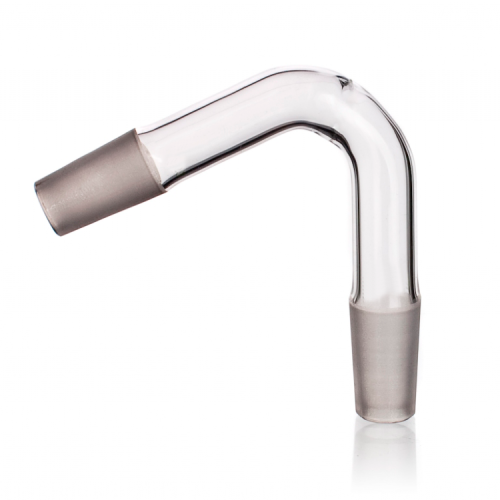75° Bend, Grind 14/23
Technical Specifications
Bend Angle: 75°
Joint Size: Grind 14/23
Material: Heat-resistant glass
Length: Customizable based on application needs
Diameter: Standardized to fit common laboratory and industrial equipment
Temperature Resistance: Up to 500°C
Pressure Rating: Suitable for low to moderate pressure applications
available soon
Solving Cramped Bench Space Problems with 75° Angular Connectors
Real lab benches aren't the spacious wonderlands shown in equipment catalogs. You've got analytical balances, hot plates, existing glassware setups, and that one piece of equipment nobody can move because it's been there since 1987.
Trying to squeeze a new distillation apparatus into this chaos with only straight connectors is like solving a Rubik's cube blindfolded. Watch what happens when you introduce this 75° bend adapter with 14/23 ground joints into a cramped setup—suddenly your condenser can angle backward toward the hood's cooling water connections instead of jutting forward into your workspace. Your collection flask positions itself at a height where you can actually see the liquid level without contorting around other glassware.
Compact Apparatus Assembly in Limited Work Areas
Fume hoods come with built-in annoyances—baffles, airflow monitors, electrical outlets positioned exactly where you need to place a flask. Standard straight-line distillation setups assume you have infinite vertical and horizontal clearance, which exists nowhere outside of fantasy.
- Baffle navigation: Route condensers around internal hood structures while maintaining proper cooling water access
- Sash visibility: Position Dean-Stark traps and receiving vessels at angles visible through the working opening
- Airflow preservation: Angle apparatus to avoid blocking hood baffles that maintain proper ventilation rates
- Support bar clearance: Thread setups between horizontal reinforcement bars in vintage hoods
One pharmaceutical QC lab uses these exclusively because their vintage hoods have support bars running horizontally at the worst possible heights—the 75-degree routing snakes apparatus between obstructions like threading a needle, except the needle is made of glass and costs three hundred dollars if you break it. Teaching labs find them indispensable for student setups where twenty distillation rigs need to coexist in limited hood space.
When connecting a Boiling Flask,round bottom to a condenser, the 75° angle lets you position the Round Bottom Flask with Ground Joint at an optimal heating angle while routing vapors away from other equipment. For receiving distillate, pair it with a Conical flask with ground section 14/23 positioned at a comfortable viewing angle—you'll actually be able to monitor collection rates without gymnastics.
14/23 Joint Integration for Small-Scale Setups
Ground glass joints work through absurdly precise surface matching—we're talking tolerances measured in hundredths of millimeters. The 14/23 designation means 14mm diameter at the top, tapering over 23mm of length, and both ends of this adapter feature female joints that accept male 14/23 glassware.
That frosted surface creates a seal so tight that many vacuum applications don't even require grease, though a whisper-thin layer of high-vacuum grease ensures you can actually separate the pieces after a week-long Soxhlet extraction. The joint length provides enough overlap for mechanical strength without excessive insertion that narrows your internal diameter and creates flow restrictions.
Natural products chemists running steam distillations appreciate how the 14/23 size handles moderate vapor volumes without creating backpressure. Graduate students working on multi-step syntheses particularly love these because you can leave one apparatus assembled while setting up the next step alongside it—the angled connections prevent the glass jungle that usually results from complex reaction sequences.
When starting with a Boiling Flask,flat bottom or Flat-Bottom Flask with Joint for reactions requiring magnetic stirring, the 75° bend routes vapors upward and away without requiring the flask to sit at awkward angles. Heat-resistant borosilicate construction means this adapter handles temperatures up to 500°C without stress fractures—drop it from six inches onto a rubber mat and it'll probably survive.
Angled Connections That Avoid Equipment Collisions
Benchtop real estate costs more than Manhattan apartments when you're trying to fit five different experiments into a four-foot hood. The bend improves ergonomics by positioning monitoring points and addition funnels at comfortable viewing angles rather than forcing you to crane your neck or peer around obstructions to check on reaction progress.
- Parallel synthesis: Run three distillations side-by-side in a single hood by angling condensers inward
- Sequential operations: Keep purification train assembled while preparing next reaction in adjacent space
- Shared equipment access: Angle setups away from communal balances and hot plates
- Multi-user environments: Compress individual workspaces to accommodate more researchers
Process chemistry groups scaling up reactions from flask to pilot plant use these during method development to simulate the angled piping they'll encounter in larger equipment, catching potential flow issues before committing to expensive fabrication. The 75° angle redirects vapor paths around obstructions while maintaining laminar flow—no turbulence, no pressure buildups, just smooth transfer from one vessel to the next.
Leave a review about product
Sign up to our newsletter to get the latest news and updates about our products.

